Hardware Projects: the GRAPE Family
Special Purpose Computers in Stellar Dynamics
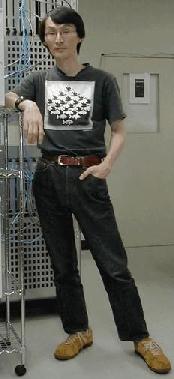 |
In 1989, we started a project at Tokyo University to build hardware specialized for stellar dynamics calculations. The first project leader was Daiichiro Sugimoto. After his retirement, Jun Makino became the head of the project.
The acronym GRAPE stands for GRAvity PipE, and designates a very efficient hardware implementation of Newtonian pair-wise force calculations between particles in a self-gravitating N-body system. Each GRAPE machine can be used in conjunction with a normal workstation, and from the user point of view the existence of the GRAPE is fully transparent. The only difference is that a library call to a Newtonian gravity evaluation results in an effective speed that is orders of magnitude faster than the nominal speed of the workstation. In this sense, the GRAPE hardware plays a role of `gravity accelerator', akin to that of a graphics accelerator (a piece of hardware that speeds up particular graphics functions).
- For an overview, including information about how to buy your own desktop GRAPE board, see the GRAPE web site.
- For an article about the GRAPE project in the popular science magazine Discover 18, No. 6, 76-83 (1997), see The Star Machine.
- A more astrophysics oriented review is Astrophysics on the GRAPE Family of Special Purpose Computers, by Hut, P. & Makino, J., 1999 Science 283, 501-505 (available in preprint form as astro-ph/9811418).
- Another review, aimed more at an engineering audience, is High-Performance Special-Purpose Computers in Science, by Fukushige, T., Hut, P. & Makino, J., 1999 IEEE Computing in Science and Engineering1, No. 2, pp. 12-13. (available in preprint form as astro-ph/9811419).
the GRAPE-3
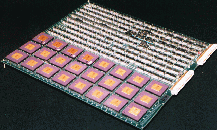 |
The GRAPE-1 and GRAPE-2 were each put together on a single board with off-the-shelf components. The GRAPE-1 was completed in 1989, and ran at a speed of 240 Mflops, at single-precision accuracy. A year later, the GRAPE-2 was finished, running at 40 Mflops, but at double precision. Their names would set the trend for the subsequent numbering scheme: odd (even) GRAPE numbers designate single (double) precision machines.
The first GRAPE-3 board was completed in 1991, and ran at 15 Gflops, already a formidable speed in those days. The increase in speed was made possible by the fact that the GRAPE-3 was the first GRAPE built using specially designed `gravity' chips, each of which effectively incorporated the design of a whole GRAPE-1 board. All subsequent GRAPEs would be built from such custom-designed chips.
One of the many applications we ran on the GRAPE-3 was a study of encounters between galaxies, where we could accurately measure for the first time cross sections for merging to take place between two galaxies. We simply used a `beam' of galaxies, aimed at a `target plate' of similar galaxies, and observed the outcome of each scattering experiment, to see which encounters would lead to only a temporary perturbation, and which would lead to the two galaxies sticking together. Our results were published in the paper Merger Rate of Equal-Mass Spherical Galaxies, by Makino, J. & Hut, P., 1997 Astrophys. J. 481, 83-94.
the GRAPE-4
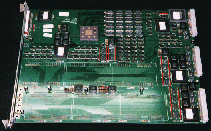 |
The first high-precision GRAPE using custom-made chips was the GRAPE-4, completed in 1995. It was also the first GRAPE to break the world speed record: it was the first computer rated at a speed of 1 Teraflops. For this, Jun Makino and Makoto Taiji received the 1995 Gordon Bell Prize. They documented their remarkable achievement, only six years after the start ot the GRAPE project, in a book Scientific Simulations with Special-Purpose Computers - the GRAPE Systems, by Makino, J. & Taiji, M. 1998 (Wiley).
For a shorter overview, see The GRAPE-4, a Teraflops Stellar Dynamics Computer, by Hut, P., 1997, in `Computational Astrophysics', the Proceedings of the 12th `Kingston meeting' on Theoretical Astrophysics, eds. D. A. Clarke and M. J. West, ASP Conference Series, Vol. 123 (San Francisco: ASP), pp. 177-188 (available in preprint form as astro-ph/9704277).
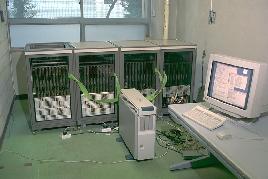 |
Most of our early work on star cluster ecology was done on various GRAPE-4 systems, from the large system at Tokyo University to single board systems in various places around the world.
The success of the GRAPE-4 prompted a discussion about the future of the GRAPE series. Would it be best to continue, with building a GRAPE-6 and GRAPE-8, each one one or two orders of magnitude faster than the previous one? Or would it make sense to extend the program to hardwire other aspects of astrophysics simulations beyond gravity? We addressed this last question in a workshop that I organized at the Institute for Advanced Study in 1997. The conclusion we reached was that it would be feasible to include forms of hydrodynamics as well as other physics, such as radiation effects and plasma physics, but that the trade-off between effort required and speed gained would be less clear than in the case of gravity-only. Given the fact that the small Tokyo group already had their hands full with building the regular GRAPE series, we would have to wait for other interested parties to take on the job of building special-purpose computers to speed up the other physics effects. Our report Smooth Particle Hydrodynamics: Models, Applications, and Enabling Technologies, by Hut, P., Hernquist, L., Lake, G., Makino, J., McMillan, S. & Sterling, T., 1997, is available in preprint form as astro-ph/9710212.
the GRAPE-6
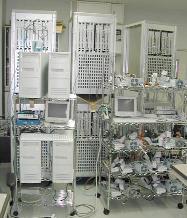 |
In the summer of 2001, the partially completed GRAPE-6 system in Tokyo University once again broke the world speed record, running at 32 Teraflops with four cabinets, each housing eight boards (a single GRAPE-6 board at 1 Teraflops is as fast as the complete four-cabinet GRAPE-4 system built six years earlier). Later that year, two more cabinets were completed, bringing the system up to 48 Teraflops.
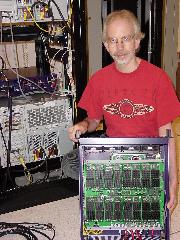 |
The total system is expected to reach a final peed around 100 Teraflops. Meanwhile, one-board systems and few-board systems can be purchased from Tokyo at a price that is one or two orders of magnitude lower than the price of commercial products running at the same speed: for less than $100,000 you now can set up a 1 Teraflops system (if you are into stellar dynamics, that is).
If funding can be found, the GRAPE-8 can be built later in this decade, and is then expected to reach a maximum speed of several Petaflops. Most likely, it will be the first computer breaking the petaflops barrier, as we predicted a number of years ago during the first conference on petaflops computing, in the paper Design Studies on Petaflops Special Purpose Hardware for Particle Simulations, by McMillan, S.L.W., Hut, P., Makino, J., Norman, M.L. & Summers, F.J., 1996, in Petaflops Architecture Workshop [Oxnard, California, April 21-25, 1996], Ch. 6.4 (available as a postscript file). We made our case in some more detail in the follow-up conference, in the paper GRAPE-6: A Petaflops Prototype, by Hut, P., Arnold, J.M., Makino, J., McMillan, S.L.W. & Sterling, T.L., 1997, in the proceedings of the 1997 Petaflops Algorithms Workshop (PAL'97), held on April 13-18, 1997 in Williamsburg, Virginia (available in preprint form as astro-ph/9704183).
Currently, we are using various GRAPE-6 systems to continue our research on star cluster ecology, as well as other topics in the stellar dynamics of star clusters and galactic nuclei. Some early results can be found in the proceedings of IAU symposium 208, Astrophysical Supercomputing Using Particles, that Jun Makino and I organized in Tokyo, in July 2001. See also the GRAPE-6 web site.